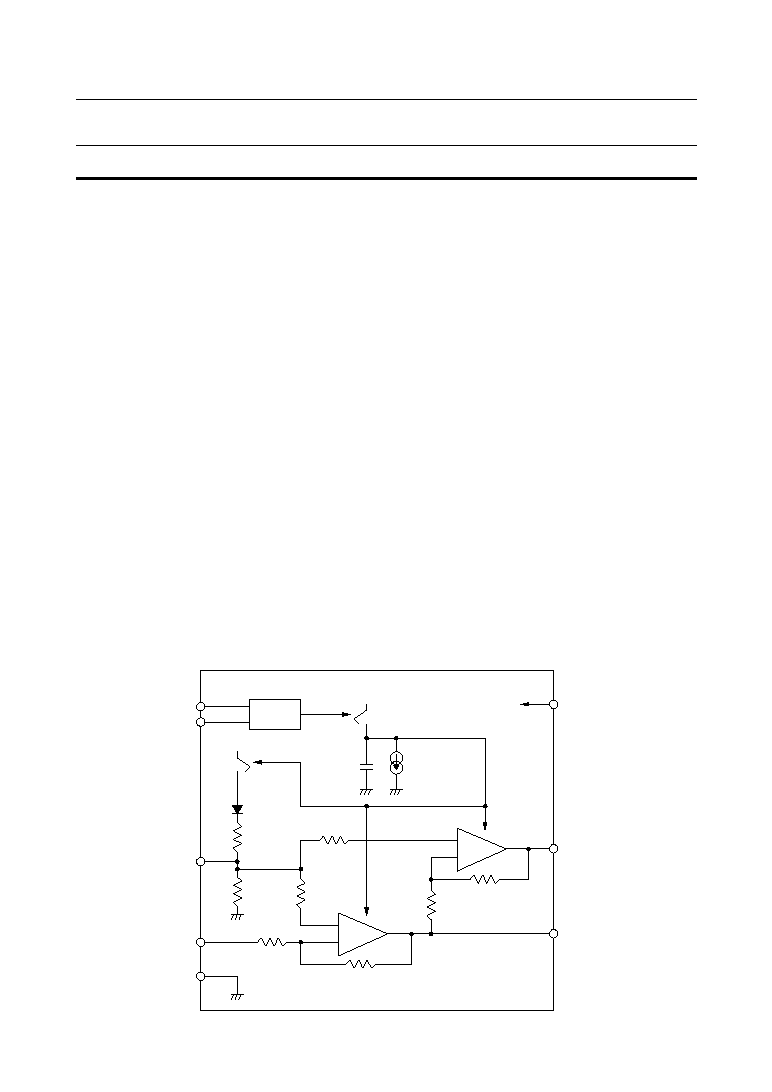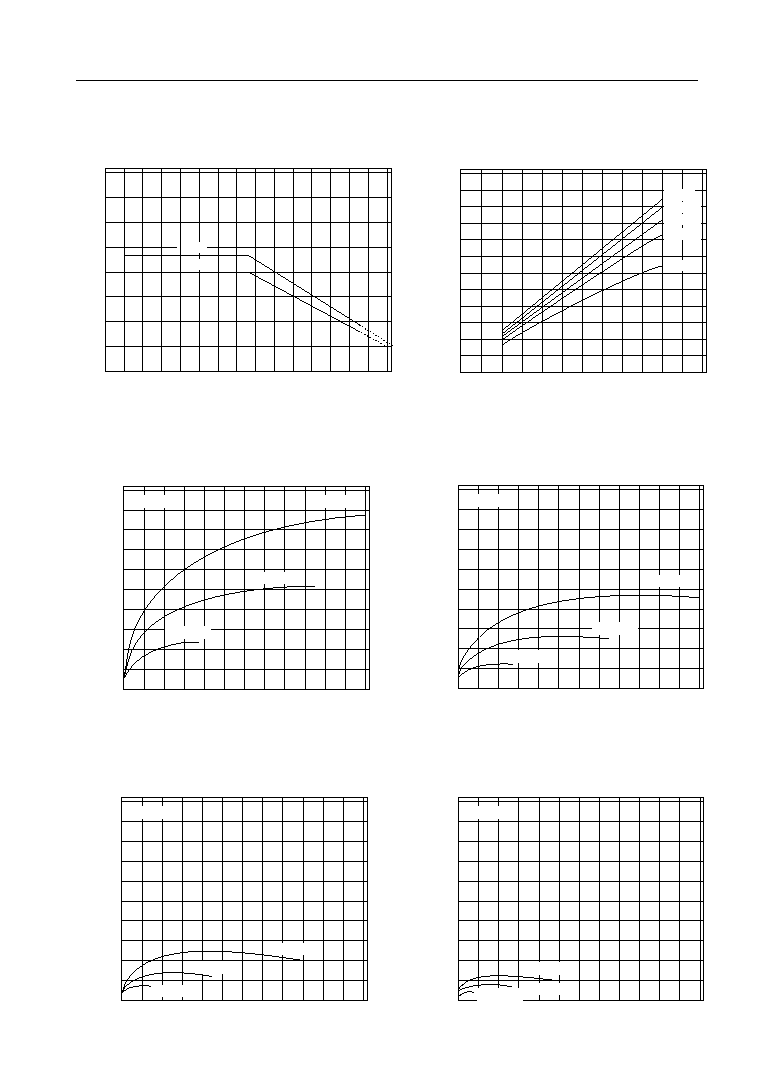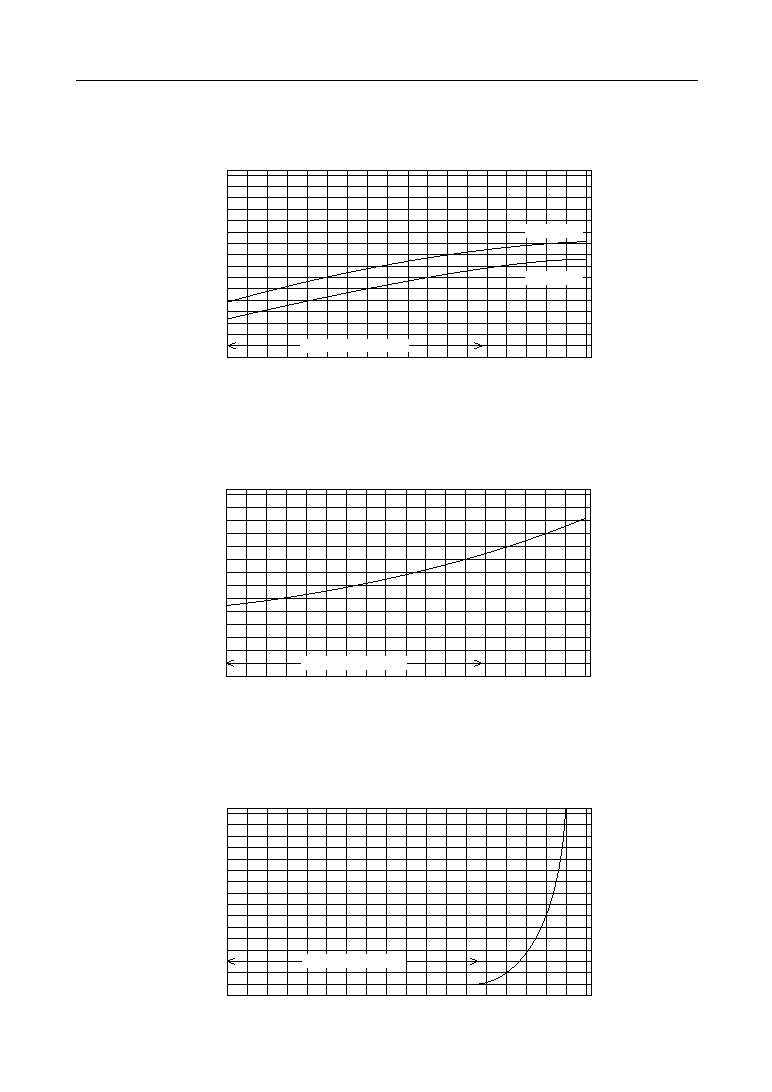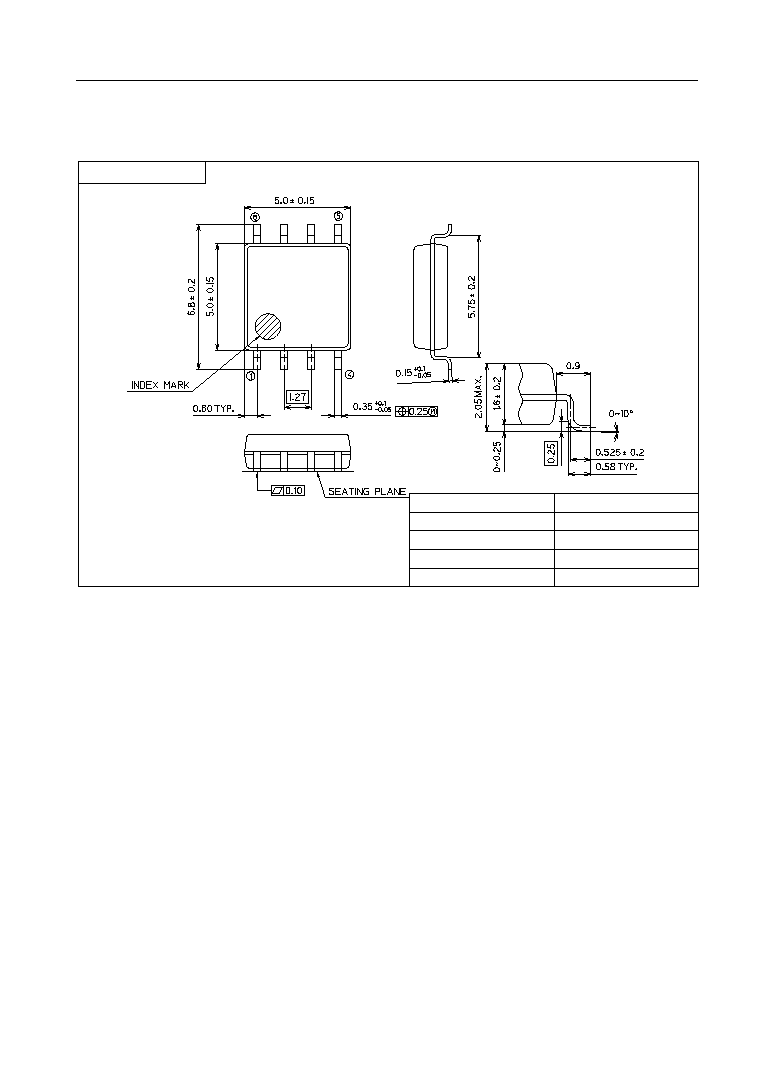
1/14
° Semiconductor
MSC1157
Speaker Drive Amplifier
GENERAL DESCRIPTION
The MSC1157, designed specifically to operate at a low voltage with low current consumption,
is a power amplifier developed for driving a speaker for a voice IC.
The voltage gains can be adjusted over a range of up to ten. The differential output can directly
drive a speaker without any output coupling capacitors. The MSC 1157, because of its ability to
stand by, is ideally suitable for portable equipment applications powered by a battery.
FEATURES
∑ Low voltage operation
: 2.0 to 6.0 V (Single power supply)
∑ Low current dissipation
Operating current
: 1.6mA without load (typ.)
∑ Standby function
: Current dissipation less than 1 mA in standby
∑ High output current
: 350mA peak
∑ Differential outputs
: A speaker can be directly connected between
differential outputs.
∑ Adjustable gain
: Gain can be adjusted by use of an external resistor.
∑ Package options:
8-pin plastic DIP (DIP8-P-300-2.54)
(Product name : MSC1157RS)
8-pin plastic SOP (SOP8-P-250-1.27-K) (Product name : MSC1157MS-K)
Chip
BLOCK DIAGRAM
VR
A
IN
GND
+
SP
SP
V
CC
≠
+
≠
20 kW
100 kW
5 kW
5 k
W
52 k
W
50 k
W
V
CC
V
CC
Logic
SEL
STBY
FEDL1157-05
This version: May. 2000
Previous version: Feb. 2000

° Semiconductor
MSC1157
2/14
FEDL1157-05
PIN CONFIGURATION (TOP VIEW)
VR
A
IN
SP
GND
SEL
STBY
SP
V
CC
1
2
3
4
8
7
6
5
8-Pin Plastic DIP
or
8-Pin Plastic SOP
PIN DESCRIPTIONS
Symbol Type
Description
V
CC
--
Power supply pin.
GND
--
Ground pin.
A
IN
I
Signal input pin for analog signal inputs, etc.
Digital input pins. Setting these pins configures the standby status. See the table below
for how to set the pins.
STBY,
SEL
I
VR
O
SP
O
Speaker output pin. This pin outputs a negative phase with respect to the input signal.
SP
O
Speaker output pin. This pin outputs a positive phase with respect to the input signal.
SEL
STBY
Status
0
Operation
0
1
Standby
Clock
Operation
0
Standby
1
1
Operation
Clock
Operation
Applying a clock between 32kHz and 4MHz to either the STBY or the SEL pin leads the IC
to operation status regardless of the status set at the other pin. Applying clocks to both
of the pins at the same time may cause malfunction.
Refer to the section, RECOMMENDED OPERATING CONDITIONS since clock frequencies
are changed by setting the SEL pin.
0
Operation
Clock
1
Operation
Clock
Unstable Operation
Bias output pin for internal circuits. This pin is at GND potential during standby.
Connecting a capacitor between VR and the GND pin reduces the pop-up noise at power
on and improves the ripple elimination ratio.
Pin
5
4
2
7, 8
1
3
6

° Semiconductor
MSC1157
3/14
FEDL1157-05
Parameter
Symbol
Power Supply Voltage
V
CC
Load Impedance (*2)
RL
Peak Load Current
I
O-P
"H" Input Voltage
V
IH
"L" Input Voltage
V
IL
STBY Operating Frequency (*3)
f
STBY
Operating Temperature
Top
Condition
For STBY and SEL pins
SEL = "L"
At clock input
V
CC
2.4 V
--
Unit
Min.
Max.
2.0
6.0
V
8.0
--
W
--
350
mA
0.7 V
CC
--
V
--
0.3 V
CC
V
32 k
4.096 M
Hz
≠40
+85
∞
C
--
--
--
SEL = "H"
At clock input
V
CC
2.4 V
32 k
1 M
ABSOLUTE MAXIMUM RATINGS
*1 Avoid shorting the output pins (SP and SP) to V
CC
or GND because the IC may be damaged.
RECOMMENDED OPERATING CONDITIONS
*2 A speaker of 8 W (standard) or more should be used.
*3 The input of clocks may cause a little noise in output waveforms.
It is recommended to input the DC voltage to inprove voice quality.
Parameter
Symbol
Condition
Rating
Unit
Remark
Power Supply Voltage
V
CC
Ta=25
∞
C
≠0.3 to +6.5
V
V
CC
Input Voltage
V
IN
Ta=25
∞
C
≠0.3 to V
CC
+0.3
V
STBY
A
IN
, SEL
Maximum Output Current
I
OMAX
Ta=25
∞
C
(*1)
±
400
mA
SP, SP
Power Dissipation
P
D
Ta=25
∞
C
470
mW
DIP type
400
mW
SOP type
Storage Temperature
T
STG
--
≠55 to +150
∞
C
Junction Temperature
T
jMAX
--
125
∞
C
Chip

° Semiconductor
MSC1157
4/14
FEDL1157-05
Parameter
Symbol
Condition
Unit
Max.
Typ.
Min.
A
IN
Input Resistance
R
IN
--
kW
26
20
14
A
V1
A
IN
∆
SP
14.49
14
13.44
Voltage Gain
A
V2
SP∆SP
dB
+1.58
0
≠1.94
A
V3
A
IN
∆(Between SP-SP)
20.51
20
19.46
P
OUT1
V
CC
=3 V, f=1 kHz
mW
--
178
100
RL=8 W, THD10%
Output Power
P
OUT2
V
CC
=6 V, f=1 kHz
mW
--
440
300
RL=32 W, THD10%
THD1
V
CC
=3 V, RL=8 W
%
--
1.2
--
f=1 kHz, P
OUT
=45 mW
Total Harmonic Distortion
THD2
V
CC
=6 V, RL=32 W
%
--
0.37
--
f=1 kHz, P
OUT
=125 mW
Ripple Elimination Ratio
RR
f=1 kHz, C2=4.7 mF
dB
--
43
30
V
O
V
Output DC Voltage
(*4)
Output Offset Voltage
DV
O
Between SP-SP
mV
±
30
--
--
V
OH
A
IN
=V
CC
or GND
V
--
V
CC
≠1.04
V
CC
≠1.15
Output "H" Voltage
I
OUT
=≠100 mA
V
OL
A
IN
=V
CC
or GND
V
0.3
0.17
--
I
OUT
=100 mA
STBY, SEL
Input Current
I
IH
V
I
=V
CC
mA
±
0.1
--
--
I
IL
V
I
=GND
mA
±
0.1
--
--
VR Equivalent Resistance
R
VR
kW
32
25
18
Circuit Current During Operation
I
CC
V
CC
=6 V, RL=∑
mA
2.4
1.6
1.1
Circuit Current During Standby
I
CCS
Ta=≠40
∞
C to +70
∞
C
mA
1.0
--
--
Output "L" Voltage
--
Unless otherwise specified, Ta=≠40 to +85
∞
C, V
CC
=2 to 6 V
V
CC
=2 V
0.77
0.65
0.53
V
CC
=6 V
2.73
2.61
2.49
In no
signal state
Ta=≠40
∞
C to +85
∞
C
10
--
--
ELECTRICAL CHARACTERISTICS
*4 The typical value of the output voltage in no signal state is determined from the following
equation.
V
O
= (V
CC
≠ 0.67)
50 kW + 52 kW
50 kW

° Semiconductor
MSC1157
5/14
FEDL1157-05
APPLICATION CIRCUIT
SEL
V
CC
STBY
A
IN
VR
SP
SP
+
≠
Standby
Select
Input
Standby
Input
Audio
Input
+
≠
C4
C3
Speaker
C2
C1
GND
∑ If parasitic capacitance of 60pF or more exists between GND and the speaker output pin SP or
SP, oscillation may occur. Implement the circuit mount design so as to be less than 60pF.
∑ C1 is the AC coupling capacitor. Cutoff frequency fc on the low frequency side is determined
by the following equation. Choose a value of C1 according to the bandwidth.
fc =
2 • p • C1 • 20k
1
(Hz)
∑ Choose a value of C2 that is 80 to 100 times as large as that of C1.
∑ When the standby function is not used, connect the pins STBY and SEL to V
CC
or GND.
∑ It is recommended that the capacitor C4 (approximately 0.1mF) having better high frequency
characteristics and the capacitor C3 (approximately 10mF) be placed between the pins V
CC
and
GND.

° Semiconductor
MSC1157
6/14
FEDL1157-05
GAIN ADJUSTMENT
1. Gain Adjustment Using Input Resistance (This approach allows gain adjustment with
fewer external components)
∑ Cutoff frequency fc on the low frequency side is determined from the equation:
fc =
2 • p • C1 • (R1 + 20k)
1
(Hz)
.
.
∑ Voltage gain A
V1
is determined from the equation:
2. Gain Adjustment Using Feedback Resistance (This approach has the advantage over
the above approach (less noise approach), but the number of components is increased)
SEL
V
CC
STBY
A
IN
VR
SP
SP
+
≠
Standby
Select
Input
Standby
Input
Audio
Input
Speaker
C2
C1
R1
R2
GND
∑ Cutoff frequency fc on the low frequency side is determined from the equation:
fc =
2 • p • C1 • Zin
1
(Hz)
.
.
Zin =
R2 + 120k
R2 • 20k
(W)
.
. R1 +
∑ Voltage gain A
V1
is determined from the equation:
A
V1
=
5
(V/V)
.
.
20k
R1
1 +
R2
6 • R1
+
SEL
V
CC
STBY
A
IN
VR
SP
SP
+
≠
Standby
Select
Input
Standby
Input
Audio
Input
Speaker
C2
C1
R1
GND
A
V1
=
R1 + 20k
100k
(V/V)
.
.

° Semiconductor
MSC1157
7/14
FEDL1157-05
OPERATING CHARACTERISTICS
12
0
10
8
6
4
2
1
2
3
4
5
6
7
Maxiumum Output Amplitude vs. Voltage Supply
Maximum Output Amplitude V
OM
[V]
Supply Voltage V
CC
[V]
RL=64W
RL=32W
RL=16W
RL=8W
RL=∑
1000
800
600
400
200
0
100
200
300
400
500
600
V
CC
=6.0V
V
CC
=4.5V
V
CC
=3.0V
Power Dissipation vs. Output Power
Power Dissipation P
D
[mW]
Output Power P
OUT
[mW]
RL=8W
1000
800
600
400
200
0
100
200
300
400
500
600
V
CC
=6.0V
V
CC
=4.5V
V
CC
=3.0V
Power Dissipation vs. Output Power
Power Dissipation P
D
[mW]
Output Power P
OUT
[mW]
RL=16W
1000
800
600
400
200
0
100
200
300
400
500
600
Power Dissipation vs. Output Power
Power Dissipation P
D
[mW]
Output Power P
OUT
[mW]
V
CC
=6.0V
V
CC
=4.5V
V
CC
=3.0V
RL=32W
1000
800
600
400
200
0
100
200
300
400
500
600
V
CC
=6.0V
V
CC
=4.5V
V
CC
=3.0V
Power Dissipation vs. Output Power
Power Dissipation P
D
[mW]
Output Power P
OUT
[mW]
RL=64W
800
0
700
600
500
400
300
200
100
-50 -40 -30
0
10 20 30 40 50 60 70 80 90 100
Power Dissipation vs. Ambient Temperature
Power Dissipation P
D
[mW]
Ambient Temperature Ta [
∞
C]
SOP
DIP
-20 -10

° Semiconductor
MSC1157
8/14
FEDL1157-05
0
1
Circuit Current vs. Voltage Supply
Circuit Current I
CC
[A]
Supply Voltage V
CC
[V]
5E-4
1E-3
1.5E-3
2E-3
2
3
4
5
6
7
10000
100
VR Rise Time vs. Capacitor Value (C2)
VR Rise Time (0 to 90%) [ms]
Capacitor C2 [mF]
1000
100
10
1
0.1
10
1
0.1
1E-2
Output Voltage vs. Load Current
Output "L" Voltage V
OL
[V]
Load Current I
OUT
[mA]
2
1.6
1.2
0.8
0.4
350
V
CC
=6.0V
V
CC
=3.0V
V
CC
=2.0V
1.8
1.4
1
0.6
0.2
300
250
200
150
100
50
0
SP Output
0
-0.4
-0.8
-1.2
-1.6
350
V
CC
=6.0V
V
CC
=3.0V
V
CC
=2.0V
-0.2
-0.6
-1
-1.4
-1.8
-2
300
250
200
150
100
50
0
Output Voltage vs. Load Current
Output "H" Voltage V
OH
(V
CC
-V
O
) [V]
Load Current I
OUT
[mA]
SP Output
2
1.6
1.2
0.8
0.4
350
V
CC
=6.0V
V
CC
=3.0V
V
CC
=2.0V
1.8
1.4
1
0.6
0.2
300
250
200
150
100
50
0
Output Voltage vs. Load Current
Output "L" Voltage V
OL
[V]
Load Current I
OUT
[mA]
SP Output
0
-0.4
-0.8
-1.2
-1.6
350
Output Voltage vs. Load Current
Output "H" Voltage V
OH
(V
CC
-V
O
) [V]
Load Current I
OUT
[mA]
V
CC
=6.0V
V
CC
=3.0V
V
CC
=2.0V
SP Output
-0.2
-0.6
-1
-1.4
-1.8
-2
300
250
200
150
100
50
0

° Semiconductor
MSC1157
9/14
FEDL1157-05
-20
Circuit Curent vs. Ambient Temperature
Circuit Current [mA]
Ambient Temperature [
∞
C]
0
20
40
100
140
-40
0.8
1
1.2
1.4
1.6
1.8
2
2.2
2.4
60
80
120
V
CC
= 6.0V
V
CC
= 2.0V
Range of Ambient Temp.
-20
VR Resistance vs. Ambient Temperature
VR Resistance [k
W
]
Ambient Temperature [
∞
C]
0
20
40
100
140
-40
36
40
44
48
52
56
60
64
60
80
120
Range of Ambient Temp.
-20
Circuit Current during Standby vs. Ambient Temperature (V
CC
= 6.0V)
Circuit Current during standby I
CCS
[
m
A]
Ambient Temperature [
∞
C]
0
20
40
100
140
-40
-0.2
0.2
0.6
1
1.4
1.8
2.2
2.6
3
60
80
120
Range of Ambient Temp.

° Semiconductor
MSC1157
10/14
FEDL1157-05
V
CC
=3V
RL=16W
V
CC
=3V
RL=8W
V
CC
=4.5V
RL=16W
V
CC
=6V
RL=32W
V
CC
=4.5V
RL=8W
V
CC
=6V
RL=16W
Total Harmonic Distortion vs. Output
Total Harmonic Distortion THD [%]
Output Power P
OUT
[mW]
f=1kHz
0
100
200
300
400
500
600
0
5
10
Total Harmonic Distortion vs. Output
Total Harmonic Distortion THD [%]
Output Power P
OUT
[mW]
f=3kHz
V
CC
=3V
RL=16W
V
CC
=3V
RL=8W
V
CC
=4.5V
RL=16W
V
CC
=6V
RL=32W
V
CC
=4.5V
RL=8W
V
CC
=6V
RL=16W
0
100
200
300
400
500
600
0
5
10
Voltage Gain vs. Frequency
Voltage Gain A
V3
[dB]
Frequency f [Hz]
-4
20
-1
2
5
8
11
14
17
20
23
26
100
1k
10k 20k
C1=0.47
mF
C1=0.22
mF
C1=0.1
mF
C1=0.047
mF
SEL V
CC
STBY
A
IN
VR
GND
SP
SP
Vi
C1
V
O
Ripple Elimination Ratio vs. Frequency
Ripple Elimination Ratio RR [dB]
Frequency f [Hz]
-80
50
-70
-60
-50
-40
-30
-20
0
10
20
100
1k
10k
20k
C2=2.2
mF
C2=4.7
mF
C2=10
mF
C2=22
mF
C2=0 mF
SEL V
CC
STBY
A
IN
VR
GND
SP
SP
Vi
C2
V
O
-10

° Semiconductor
MSC1157
11/14
FEDL1157-05
PAD CONFIGURATION
Pad Layout
Chip size
: X=2.3mm, Y=2.4mm
Chip thickness
: 350
±
30mm
Pad size (PV aperture)
: 110•110mm
Substrate potential
: GND
Pad location diagram (This pad layout indicates the view from the bonding pad side.)
2
1
8
7
6
5
4
3
Y-Axis
X-Axis
Pad No.
Pad Name
X-AXIS
Y-AXIS
1
VR
≠133
1035
2
A
IN
≠985
1035
3
SP
≠950
≠263
4
GND
≠180
≠1027
5
V
CC
240
≠914
6
SP
950
≠263
7
STBY
985
1035
8
SEL
159
1035
(Unit:
µ
m)
Pad Coordinates
(Chip center is located at X=0 and Y=0.)

° Semiconductor
MSC1157
12/14
FEDL1157-05
(Unit : mm)
PACKAGE DIMENSIONS
DIP8-P-300-2.54
Package material
Lead frame material
Pin treatment
Package weight (g)
Oki Electric Industry Co., Ltd.
Rev. No./Last Revised
Epoxy resin
42 alloy
Solder plating (5 mm)
0.46 TYP.
2/Dec. 11, 1996

° Semiconductor
MSC1157
13/14
FEDL1157-05
(Unit : mm)
Notes for Mounting the Surface Mount Type Package
The SOP, QFP, TSOP, TQFP, LQFP, SOJ, QFJ (PLCC), SHP, and BGA are surface mount type
packages, which are very susceptible to heat in reflow mounting and humidity absorbed in
storage. Therefore, before you perform reflow mounting, contact Oki's responsible sales person
on the product name, package name, pin number, package code and desired mounting conditions
(reflow method, temperature and times).
SOP8-P-250-1.27-K
Mirror finish
Package material
Lead frame material
Pin treatment
Package weight (g)
Oki Electric Industry Co., Ltd.
Rev. No./Last Revised
Epoxy resin
42 alloy
Solder plating (5 mm)
0.10 TYP.
4/Dec. 5, 1996

14/14
FEDL1157-05
Printed in Japan
NOTICE
1.
The information contained herein can change without notice owing to product and/or
technical improvements. Before using the product, please make sure that the information
being referred to is up-to-date.
2.
The outline of action and examples for application circuits described herein have been
chosen as an explanation for the standard action and performance of the product. When
planning to use the product, please ensure that the external conditions are reflected in the
actual circuit, assembly, and program designs.
3.
When designing your product, please use our product below the specified maximum
ratings and within the specified operating ranges including, but not limited to, operating
voltage, power dissipation, and operating temperature.
4.
Oki assumes no responsibility or liability whatsoever for any failure or unusual or
unexpected operation resulting from misuse, neglect, improper installation, repair, alteration
or accident, improper handling, or unusual physical or electrical stress including, but not
limited to, exposure to parameters beyond the specified maximum ratings or operation
outside the specified operating range.
5.
Neither indemnity against nor license of a third party's industrial and intellectual property
right, etc. is granted by us in connection with the use of the product and/or the information
and drawings contained herein. No responsibility is assumed by us for any infringement
of a third party's right which may result from the use thereof.
6.
The products listed in this document are intended for use in general electronics equipment
for commercial applications (e.g., office automation, communication equipment,
measurement equipment, consumer electronics, etc.). These products are not authorized
for use in any system or application that requires special or enhanced quality and reliability
characteristics nor in any system or application where the failure of such system or
application may result in the loss or damage of property, or death or injury to humans.
Such applications include, but are not limited to, traffic and automotive equipment, safety
devices, aerospace equipment, nuclear power control, medical equipment, and life-support
systems.
7.
Certain products in this document may need government approval before they can be
exported to particular countries. The purchaser assumes the responsibility of determining
the legality of export of these products and will take appropriate and necessary steps at their
own expense for these.
8.
No part of the contents contained herein may be reprinted or reproduced without our prior
permission.
9.
MS-DOS is a registered trademark of Microsoft Corporation.
Copyright 2000 Oki Electric Industry Co., Ltd.













